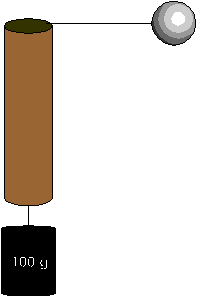
Objects moving in circles
#1 What do we call a force that keeps an object on a curved path, and what do we need to know to determine the magnitude and direction of the force?
| Use the centripetal force apparatus to check the centripetal force relation. The centripetal force apparatus consists of a smooth-lipped straight tube and a string passing through the tube. A metal ball is attached to one end of the string, and a weight is hanging from the other. |
 |
1. Holding the tube vertically, twirl it so that the ball circles the top of the tube in such a way that the tension in the string holds up the weight attached to the bottom end of the string. |
 |
| 2. Time the circling ball for twenty passes, determine the radius of the circle and the mass of the ball, and calculate the centripetal force. Compare the magnitude of the centripetal force to the weight of the ball. |
| Note: The string must remain in the horizontal plane, or else the weight of the ball due to gravity must be considered |
#2 In a sentence or two, report your findings below.
The satellites circle the Earth because an invisible force keeps them "tied" to the Earth and prevents them from flying away into the universe along a straight line path. The little ball that you twirled was tied to the stick with a string. The tension in the string provided
the centripetal force to keep the ball from flying away.
#3 What pulls on the satellites to prevent them from flying away?
 Click here to return to the Lesson Map
Click here to return to the Lesson Map



 Click here to return to the Lesson Map
Click here to return to the Lesson Map